Iowa, often overlooked for its natural treasures, offers a bountiful haven for mushroom hunters. The state’s rich woodlands and varied climates create a perfect environment for both novice and experienced foragers. Whether you are in it for the culinary delights or the excitement of the hunt, this comprehensive Iowa mushroom hunting guide will help you navigate the fascinating world of fungi.

Why Hunt Mushrooms in Iowa?
What Makes Iowa Unique for Mushroom Hunters?
Iowa’s diverse ecosystem boasts a variety of mushrooms that are both edible and toxic, making it essential for hunters to have a good understanding of the types of fungi they might encounter. The state’s woodlands, especially those with decaying trees and rich leaf litter, offer fertile ground for species like morels, chanterelles, and oyster mushrooms. Seasonal changes also play a key role, with spring and fall being prime times for mushroom hunting in Iowa.
The Joy of the Hunt
There’s an unparalleled excitement in discovering mushrooms in their natural habitats. The thrill of the hunt combines outdoor adventure with the satisfaction of finding something valuable and often delicious. For many, mushroom hunting is a family tradition passed down through generations, fostering a deep connection with nature.
When and Where to Hunt: Timing and Locations
Best Seasons for Mushroom Hunting
Spring and fall are the prime seasons for mushroom hunting in Iowa. In spring, morels are the stars of the show. Morels start to appear when the soil temperature stays above 50°F, usually between late April and early June. Fall brings an abundance of different species, including hen-of-the-woods and puffballs, thriving in the cooler temperatures and increased moisture.
Top Spots for Mushroom Hunting in Iowa
1. **Yellow River State Forest**: This forest is known for its diverse species, including morels, chanterelles, and maitake (hen-of-the-woods). Its varied terrain provides ample opportunities for finding hidden mushroom troves.
2. **Ledges State Park**: With its lush woodlands and rich soil, Ledges State Park is a popular spot for foragers. The park’s trails make it accessible for both beginners and seasoned hunters.
3. **Shimek State Forest**: Located in the southeast, Shimek State Forest is a mushroom hunter’s paradise with its extensive woodlands and moist environment, perfect for a variety of fungi.
Tips for Successful Mushroom Hunting in Iowa
Know Your Mushrooms
Identifying mushrooms accurately is crucial. Familiarize yourself with common edible species in Iowa and their toxic look-alikes. Carry a reliable mushroom identification guide, or better yet, join a local mycological society where you can learn from experienced hunters.
Respect Nature
Always practice sustainable foraging. Don’t overharvest mushrooms; leave some behind to ensure they can reproduce and sustain future populations. Avoid damaging the habitat and be mindful of the local wildlife.
Stay Safe
Mushroom hunting can take you into remote areas. Always let someone know where you’re going and when you plan to return. Wear appropriate clothing and bring supplies like water, first aid, and a compass or GPS device.
Preparing and Enjoying Your Foraged Finds
Cleaning and Storing Mushrooms
Once you’ve collected your bounty, it’s essential to clean and store your mushrooms properly. Use a soft brush to remove dirt and debris, avoid washing them until you’re ready to cook, and store them in paper bags in the refrigerator to keep them fresh.
Cooking Ideas
Mushrooms can be the star ingredient in numerous dishes. Sauté them with garlic and herbs for a simple yet delicious side dish, or incorporate them into soups, pastas, and risottos. The possibilities are endless, and the flavors are unparalleled.
In conclusion, this Iowa mushroom hunting guide is your key to unlocking the natural wonders hidden in Iowa’s forests. With the right knowledge and respect for nature, you can enjoy the thrilling and rewarding experience of mushroom hunting, while also savoring the fruits of your labor. Happy hunting!



